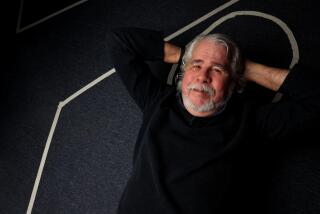GASLAMP TAKES BIG LEAP WITH DEANE
SAN DIEGO — Since it opened in 1980, one of the interesting quirks of the snug, 90-seat Gaslamp Quarter Theatre is that the actors and audience members share the same restroom backstage.
At the Gaslamp, it is possible to be greeted by, say, an arch Noel Coward figure, rushing out of the loo.
That is not the case at the Gaslamp’s sparkly new second stage, the Deane Theatre, which represents a landmark in the Gaslamp’s development--not just because of its amenities, including separate restrooms for audiences. The Deane, which opened Wednesday with Somerset Maugham’s comedy, “The Circle,” marks an artistic and financial expansion by Gaslamp management.
From now on, all performances in both theaters will employ union stage managers and actors in half the roles for each production, under a contract the theater sought with Actor’s Equity, the professional actors union. In practical terms, that agreement spells a commitment to pay actors more money. It also means that, along with operating two theaters, the Gaslamp’s budget this year will be just shy of $1 million. That’s a quantum jump from last year’s $300,000 budget.
The expansion, coming just a year after the San Diego Symphony’s ill-timed renovation and purchase of Symphony Hall, has the theater’s staff and board members a little edgy about possible community reaction.
“There’s a lot of concern of can we account for this or that (expenditures) in light of the symphony situation,” business manager James Strait said. “So far, we have all been pretty accountable.”
A major reason for the concern about accountability is the man whose name is on the theater, Charles Deane. Deane, a retired precious-metals trader who knows what the bottom line is, agreed reluctantly to be the theater’s namesake after donating $1,000 for each of the theater’s 250 seats.
In budgeting the costs of operating two theaters, Deane said the patrons “started with the income, then matched the expenses. We started with what we thought we could raise, then cut expenses after estimating donations.”
Symphony officials have acknowledged that part of their problems came from trying to stretch their fund-raising ability to match increased expenses.
Another key player in building the Deane is developer Ernest Hahn. Hahn, whose company developed Horton Plaza and had earlier underwritten a play for the Gaslamp, volunteered to raise $725,000 to help pay for the new theater. Hahn said that almost all of that goal has been met.
“I have a real interest in seeing a theater district emerge because it would help all of downtown,” Hahn said. “I particularly think that Kit (Goldman, the theater’s managing producer) and that group--the whole gang--deserve some help. They do a good job in the Gaslamp . . . and the Gaslamp and the Deane are downtown.”
Goldman, the theater’s energetic managing producer, also snared Deane. “The first thing I liked about (Kit) is she doesn’t take no for an answer,” Deane said. “She’s a woman running a small theater in a man’s world. She has tremendous drive and tenacity.”
Goldman co-founded the theater along with Artistic Director Will Simpson, resident designer Robert Earl, and the original technical director, Tony Wood. Earl designed the new Deane, and Simpson has directed the first production.
Goldman sees the expansion as an opportunity for San Diego actors.
“When you get to the point where your horizons begin to expand,” she said, “I feel a strong compulsion to include those people (the local actors) that got you there.”
That includes the ability to offer Equity union cards to longtime Gaslamp actors.
The smaller of the Gaslamp’s two theaters will be used for plays of a more experimental nature, such as “I Won’t Dance” by Oliver Hailey, while the Deane will feature shows with a broader appeal, such as “The Real Thing” by Tom Stoppard.
The Deane Theatre is unlike any other nonprofit “brick and mortar” arts project in San Diego. The construction of the $3.3-million, three-story structure (it includes theater offices and offices of the adjacent Horton Grand Hotel) was paid for entirely from private and corporate money sources. (The City of San Diego did award a $150,000 grant to help with operating expenses.)
The Gaslamp’s limited resources could not pay for the entire theater, so a unique financial plan was devised to raise the $3.3 million, including a $1-million limited partnership offering, a $1.6-million bank loan and the $725,000 raised by the theater.
Although the nonprofit Gaslamp theater group raised money to build the playhouse, it will pay the limited partnership $10,000 a month rent. “We pay a lot of rent,” Deane said. “But it’s a lot less than we would pay anywhere else. We paid a lot to build it, but it was a lot less than we would have paid anywhere else.”
Goldman’s husband, Dan Pearson, conceived and developed the new theater. Because it is a reconstruction of the old San Diego Paper Box Factory, the theater has provided the investors with $360,000 in federal income tax credits.
Although the theater has not raised all of the $725,000, Deane, who has been involved “almost daily” with the theater staff, said there is a large financial cushion to protect against cash flow problems.
“Obviously, I don’t have a crystal ball about attendance and donations,” Deane said. “But we haven’t forced the budget. As long as San Diego gives us a reasonable attendance, we’ll manage.”
More to Read
The biggest entertainment stories
Get our big stories about Hollywood, film, television, music, arts, culture and more right in your inbox as soon as they publish.
You may occasionally receive promotional content from the Los Angeles Times.










